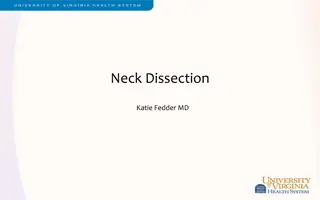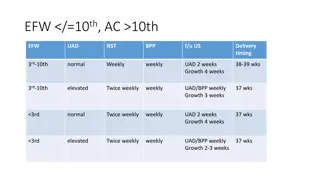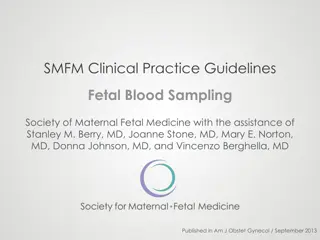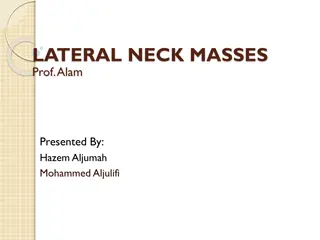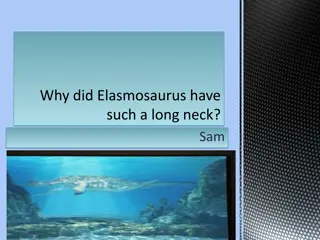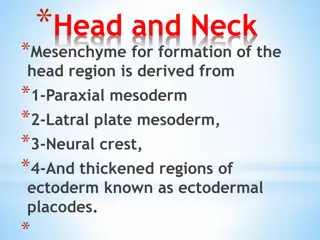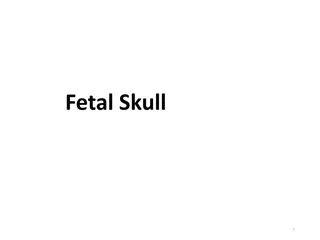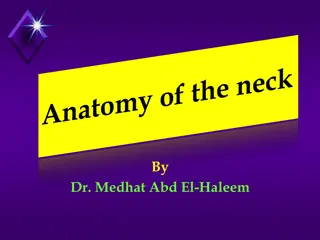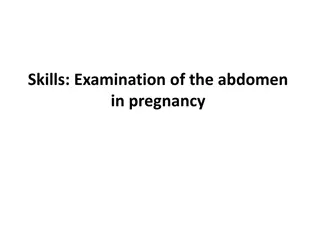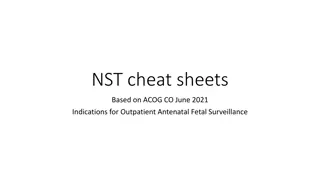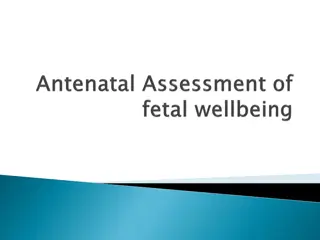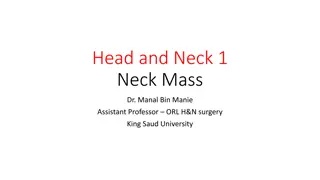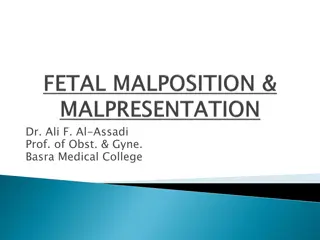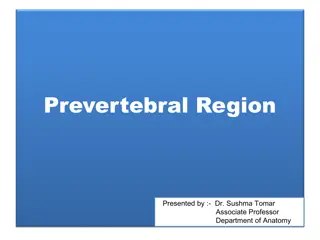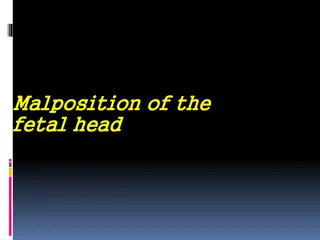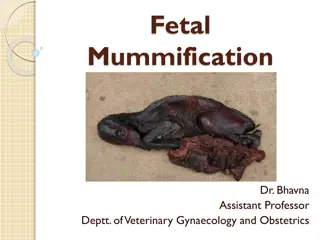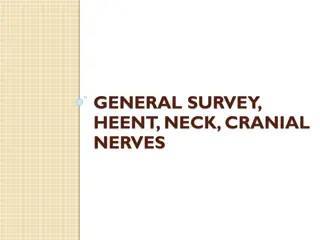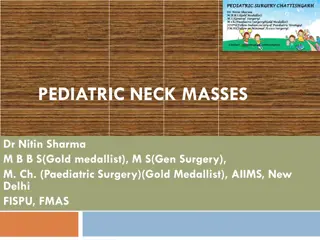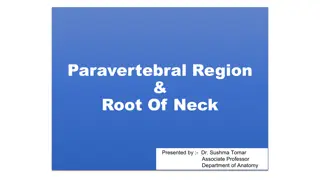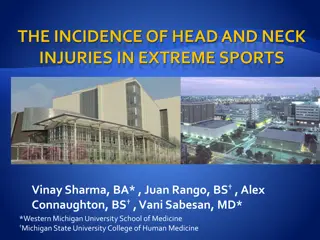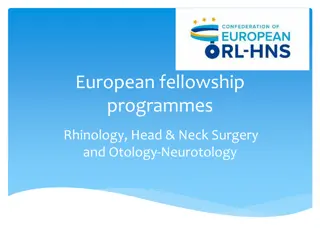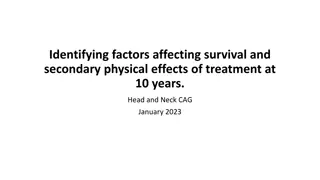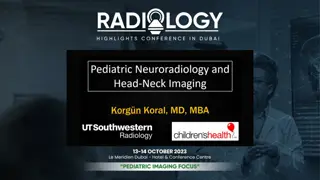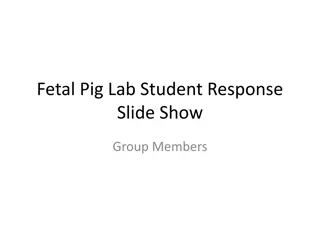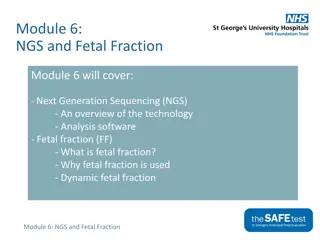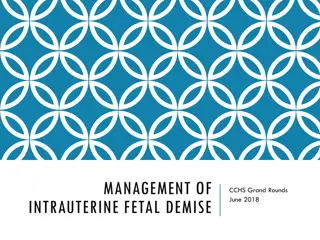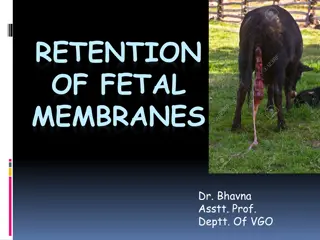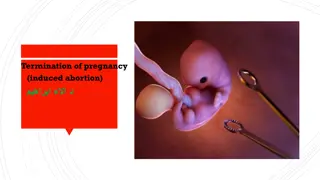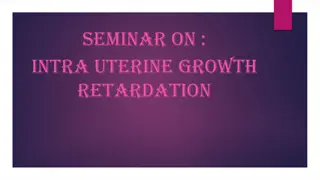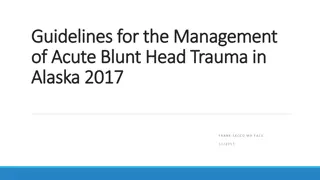Development of Fetal Head and Neck Structures in Week 12
The fetal head and neck structures in week 12 exhibit a complex formation process involving contributions from all three embryonic layers and the neural crest. Neural crest plays a significant role in developing jaw skeletal elements, connective tissues, and tendons. The pharynx, starting at the buccopharyngeal membrane, contributes to the formation of endocrine organs and the tongue. Pharyngeal arch components form various head and neck structures, with distinct features identified for each arch, including pouches, grooves, and membranes. The first arch notably contributes to upper and lower jaw structures.
Download Presentation

Please find below an Image/Link to download the presentation.
The content on the website is provided AS IS for your information and personal use only. It may not be sold, licensed, or shared on other websites without obtaining consent from the author. Download presentation by click this link. If you encounter any issues during the download, it is possible that the publisher has removed the file from their server.
E N D
Presentation Transcript
The head and neck is not really a "system", but structurally quite different in origin from the body. The head and neck are one of the most complicated structures that the embryo forms, with special intermediate structures (the pharyngeal arch) and contributions from all 3 embryonic layers (ectoderm, mesoderm, endoderm), and significantly, a major contribution from the neural crest.
Neural crest contributes jaw skeletal elements, connective tissues and tendons. The associated muscles derive mainly from cranial mesoderm. These components though will form different structures dependent upon which arch they are within. The cavity within the pharyngeal arches forms the pharynx.
The Pharynx: - begins at the buccopharyngeal membrane (oral membrane), apposition of ectoderm with endoderm (no mesoderm between) The pharynx contributes to 2 endocrine organs, in the roof the pituitary (hypophysis) and the floor the thyroid. The thyroid gland, being one of the first endocrine organs to be formed, has an important role in embryonic development. The pharynx floor of all arches also contribute to the formation of the tongue.
Pharyngeal (branchial) ( visceral) Arch Components: Human embryo pharyngeal arches Contribute to the formation of head and neck and in the human appear at the 4th week. Major features to identify for each arch: 1-Pouch: internally separates each arch ,pockets from the pharynx 2- Groove(cleft): externally separates each arch also called a cleft only first pair persist as external auditory meatus
3-Membrane: ectoderm and endoderm contact regions only first pair persist as tympanic membrane The first arch contributes the majority of upper and lower jaw structures
Pharyngeal Arch Development branchial arch (Gk. branchia= gill) arch consists of all 3 trilaminar embryo layers ectoderm- outside mesoderm- core of mesenchyme: the mesodermal core of each visceral arch is concerned primarily with the formation of vascular endothelial cells. As noted below, these cells appear to be later replaced by cells that eventually form visceral arch myoblasts. endoderm- inside
Arch Features Each arch contains: artery, cartilage, nerve, muscular component Arches and Phanynx Form the face, tongue, lips, jaws, palate, pharynx and neck cranial nerves, sense organ components, glands Humans have 5 arches - 1, 2, 3, 4, 6 (Arch 5 does not form or regresses rapidly) from in rostro-caudal sequence, Arch 1 to 6 from week 4 onwards arch 1 and 2 appear at time of closure of cranial neuropore As the heart recedes caudally,1 and 2 arches send out bilateral processes that merge with their opposite members in the ventral midline. Face - mainly arch 1 and 2
Neck components - arch 3 and 4 (arch 4 and 6 fuse) Myoblast cells in the visceral arches actually originate from mesoderm more closely associated with the neural tube (cells that form the hypoglossal and extrinsic eye musculature). They would then migrate into the visceral arches and replace the mesodermal cells that initiated blood vessel formation earlier.
It therefore appears that myoblasts forming voluntary striated muscle fibers of the facial region would then originate from mesoderm adjacent to the neural tube. Groups of visceral arch myoblasts that are destined to form individual muscles each take a branch of the appropriate visceral arch nerve.
Pharyngeal Arch 1 (Mandibular Arch) has 2 prominences: smaller upper- maxillary forms maxilla, zygomatic bone and squamous part of temporal larger lower- mandibular, forms mandible
Pharyngeal Arch 2 (Hyoid Arch) forms most of hyoid bone Arch 3 and 4 neck structures
Arch Arteries Arch 1 - mainly lost, form part of maxillary artery Arch 2 - stapedial arteries Arch 3 - common carotid arteries, internal carotid arteries Arch 4 - left forms part of aortic arch, right forms part right subclavian artery Arch 6 - left forms part of left pulmonary artery , right forms part of right pulmonary artery placental vein -> liver -> heart -> truncus arteriosus -> aortic sac -> arch arteries -> dorsal aorta -> placental artery
Arch Cartilage :Meckel's cartilage, first pharyngeal arch Pharyngeal arch cartilages Arch 1 - Meckel's cartilage, horseshoe shaped dorsal ends form malleus and incus midpart forms ligaments (ant. malleus, sphenomandibular) ventral part forms mandible template
Arch 2 - Reichert's cartilage dorsal ends form stapes and Temporal bone styloid process ventral part ossifies to form hyoid bone components lesser cornu and superior part of hyoid body Arch 3- forms greater cornu and inferior part of hyoid body Arch 4&6- form laryngeal cartilages, except epiglottis (from hypobranchial eminence)
Arch Muscle Arch 1 - muscles of mastication, mylohyoid, tensor tympanic, and ant. belly digastric Arch 2 - muscles of facial expression, stapedius, stylohyoid, and post. belly digastric Arch 3 - stylopharyngeus Arch 4&6 - crycothyroid, pharynx constrictors, larynx muscles, oesophagus muscles
Arch Nerve: Arch 1 - CN V trigeminal, caudal 2/3 maxillary and mandibular, cranial 1/3 sensory nerve of head and neck, mastication motor Arch 2 - CN VII facial Arch 3 - CN IX glossopharyngeal Arch 4&6 - CN X vagus, arch 4- superior laryngeal, arch 6- recurrent laryngeal
Arch Pouches Arch 1 - elongates to form tubotympanic recess, tympanic cavity, mastoid antrum, eustachian tube Arch 2 - forms tonsillar sinus, mostly oblierated by palatine tonsil Arch 3 - forms inferior parathyroid and thymus Arch 4 - forms superior parathyroid, parafollicular cells of Thyroid
Thyroid Gland not a pouch structure first endocrine organ to develop at day 24from floor of pharynx The thyroid gland forms by invagination of the most anterior endoderm (thyroglossal duct). descends thyroglossal duct upper end at foramen cecum. A residual pit (the foramen cecum) left in the epithelium at the site of invagination marks the junction between the anterior two thirds and posterior one third of the tongue, which are, respectively, covered by epithelia of ectodermal and endodermal origin.
Anterior Pituitary: The pituitary gland develops as a result of inductive interactions between the ventral forebrain and oral ectoderm and is derived in part from both tissues. Following initial neural crest cell migration, these cells invade the area of the developing pituitary gland and are continuous with cells that will later form the maxillary prominence. Eventually, neural crest cells form the connective tissue components of the gland.
Sensory placodes (week 5) During week 4 a series of thickened surface ectodermal patches form in pairs rostro-caudally in the head region. These sensory placodes will later contribute key components of each of our special senses (vision, hearing and smell). Note that their initial position on the developing head is significantly different to their final position in the future sensory system
1-Otic placodes: In the stage 13/14 embryo ; the otic placode has sunk from the surface ectoderm to form a hollow epithelial ball, the otocyst, which now lies beneath the surface surrounded by mesenchyme (mesoderm). The epithelia of this ball varies in thickness and has begun to distort, it will eventually form the inner ear membranous labyrinth.
2-Lens placode lies on the surface, adjacent to the outpocketing of the nervous system (which will for the retina) and will form the lens. 3-Nasal placode Has 2 components (medial and lateral) and will form the nose olfactory epithelium.
Head Growth Continues postnatally - fontanelle allow head distortion on birth and early growth Bone plates remain unfused to allow growth, puberty growth of face
Skull : 1-Chondrocranium - chondrocranium forms base of skull; derived from paraxial mesoderm in lower vertebrates encases brain 2-cranial end of vertebral column modified vertebral elements occipital and cervical sclerotome bone preformed in cartilage (endochondrial ossification)
3-Cranial Vault and Facial Skeleton - formed from neural crest muscle is paraxial mesoderm somitomeres and occipital somites 4-Calveria - bone has no cartilage (direct ossification of mesenchyme) Bones do not fuse, fibrous sutures 1. allow distortion to pass through birth canal 2. allow growth of the brain 6 fontanelles, posterior closes at 3 months, anterior closes at 18 months
Ear development: Ear Auricles: form from 6 hillocks (week 5), 3 on each of arch 1 and 2. Lateral extension from the inner groove between the first and second arch gives rise to the eustachian tube, which connects the pharynx with the ear. The external ear, or pinna, is formed at least partially from tissues of the first and second arches .



